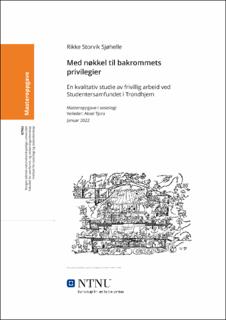| dc.contributor.advisor | Tjora, Aksel | |
| dc.contributor.author | Sjøhelle, Rikke Storvik | |
| dc.date.accessioned | 2023-03-11T18:19:25Z | |
| dc.date.available | 2023-03-11T18:19:25Z | |
| dc.date.issued | 2022 | |
| dc.identifier | no.ntnu:inspera:123989580:31565602 | |
| dc.identifier.uri | https://hdl.handle.net/11250/3057791 | |
| dc.description.abstract | Denne masteroppgaven tar for seg hva det er som gjør at frivillige ved Studentersamfundet i Trondhjem legger inn betydelig innsats og tid i organisasjonen og bygget. Gjennom kvalitative dybdeintervju har jeg forsket på tre gjenger, altså grupper på Samfundet, som representerer hver sine virksomhetsområder. Gjengene er Regi, Klubbstyret og Studentersamfundets Interne Teater (SIT). Det har vært særlig viktig å avdekke hva de romlige forutsetningene har å si for innsats på huset, og hvilken relasjon det er mellom tidsbruk og sosial samhandling. I analysen utforsker jeg hvordan deltagerne bruker Samfundet, hvorfor stedet og organisasjonen er viktig for dem og hva de gjør når de er der. Jeg identifiserte fire kategorier. Den første handler om at de frivillige kan leke seg, både nyttig og unyttig lek. Den andre identifiserer viktigheten av de frivilliges nøkkelkort som gir fysisk og sosial tilgang. Den tredje går ut på å vise Samfundets sykluser i form av aktiviteter og tradisjoner viser at tidsperspektivet er viktig, og den fjerde kategorien viser hvordan deltagerne opplever Samfundet som et hjem.
Deltagernes erfaring har blitt belyst og diskutert gjennom et bredt spekter av sosiologisk, psykologisk, pedagogisk og filosofisk teori som omhandler dramaturgi, flyt, lek, tid og innlemmelse. I tillegg bruker jeg begrepet tredjeplasser fra urban sosiologi. I diskusjonen lager jeg en metafor for å forstå de frivilliges bruk av Samfundet. Med familiebilder på veggene, egne lekerom og stue sammenligner jeg det med et hjem, særlig på bakrommet, altså de private områdene på Samfundet. I tillegg etablerer jeg to begreper. Huskompetanse handler om ha kunnskap om det fysiske bygget. Når, hvor, og hva de sosiale ritualene og aktivitetene innebærer. Noe man kan ha huskompetanse om er husrytme. Husrytmen deler opp kvelden i ulike faser og gir rommene nye funksjoner basert på situasjonene. De interne opplever at de har nøkkel til bakrommets privilegier. Nøkkelen er både et konkret nøkkelkort (internkort) med faktiske tilganger og et abstrakt symbol på innlemmelse med tilgang på huskompetanse og deltagelse i husrytmen. | |
| dc.description.abstract | This master's thesis examines what makes volunteers at the Studentersamfundet in Trondhjem invest considerable effort and time in the organization and the building. Through qualitative in-depth interviews, I have researched three gangs, i.e. groups at Samfundet, which each represent their own areas. The gangs are Regi, Klubbstyret and Studentersamfundets Interene Teater (SIT). It has been particularly important to uncover what the spatial conditions contribute for volunteers invest in house, and what relationship there is between time use and social interaction. In the analysis, I explore how the participants use Samfundet, why the place and the organization are important to the volunteers and what they do when they are there. I identified four categories. The first is about the volunteers being able to play around, both useful and useless play. The second identifies the importance of the volunteers' key cards that provide physical and social access. The third involves showing the Samfundets cycles in the form of activities and traditions showing that the time perspective is important, and the fourth category shows how the participants experience Samfundet as a home.
The participants' experience has been illuminated and discussed through a wide range of sociological, psychological, educational and philosophical theory that deals with dramaturgy, flow, play, time and incorporation. In addition, I use the concept of third places from urban sociology. In the discussion, I create a metaphor to understand the volunteers' use of Samfundet. With family photos on the walls, having their own playrooms and living room, I compare it to a home, especially in the backstage, i.e. the private areas at Samfundet. In addition, I establish two concepts. House competence is about having knowledge of the physical building. When, where, and what the social rituals and activities involve. Something you can have house expertise about is house rhythm. The house rhythm divides the evening into different phases and gives the rooms new functions based on the situations. The volunteers feel that they have the key to the privileges of the back room. The key is both a concrete key card with actual access and an abstract symbol of incorporation with access to house competence and participation in the house rhythm. | |
| dc.language | nob | |
| dc.publisher | NTNU | |
| dc.title | Med nøkkel til bakrommets privilegier | |
| dc.type | Master thesis | |
